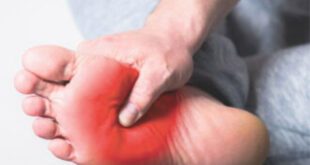Dr. John Bidelspach
 November is American Diabetes Month; a time to bring to light the crippling nature of this looming public health crisis. Diabetes is a serious disease, one that affects the entire body: the kidneys, heart, blood vessels, brain and more.
November is American Diabetes Month; a time to bring to light the crippling nature of this looming public health crisis. Diabetes is a serious disease, one that affects the entire body: the kidneys, heart, blood vessels, brain and more.
But as a Podiatrist, I’d like to address one of the most frightening aspects of the disease: your feet.
People with diabetes are at significantly increased risk for developing foot problems and suffering amputation of the toes, feet, and even leg. For this reason, it is very important those with diabetes take special care of their feet.
Problems that could be ignored before diabetes cannot be ignored after. Diabetics tend to develop serious foot problems quickly and have more complications as a result than people without the disease. For example, a small irritation like an open blister in a healthy person could become a severe issue to a diabetic.
The key is to view all foot problems as potentially dangerous and to prevent them through diligence and by seeking podiatric care as soon a problem appears.
Pay attention to your feet!
Having diabetes forces you to change your life, including treating your feet like the special structures they are. To keep your feet healthy and whole, I recommend my patients with diabetes:
1. Inspect their feet daily for calluses, cracks or wounds. If you develop any of these, get in touch with your podiatrist right away to have them addressed.
2. Be gentle to your feet when washing them.
3. Moisturize your feet daily, using a product that is free of alcohol. Do not use moisturizer between your toes.
4. Cut your nails carefully and straight across. If you need help cutting your nails, call our office. Medicare will pay for regular trimming of toenails for individuals with diabetes.
5. Never, never, never trim or cut your corns or calluses.
6. Make sure your socks are clean and dry. Change them at least daily (more often if your feet sweat or you work in a dirty area).
7. Make sure your socks are neither too loose (can rub and cause blisters) or too tight (can restrict circulation).
8. Avoid temperature extremes.
9. Inspect your shoes before putting them on. Shake out the inside to remove any pebbles, sand or other objects that might irritate your feet.
10. Keep your feet warm and dry.
11. Break in new shoes slowly and make sure to purchase shoes that fit you properly. If you’re in doubt, come see us. We can help make sure you get the right fit.
12. Never go barefoot. Many diabetics don’t realize that they may qualify for diabetic shoes and insoles. Don’t despair! They are much more fashionable than they used to be and have the extra depth that is required.
13. Make sure to get your feet checked yearly by a Podiatrist.
Dr. John Bidelspach
Dr. B graduated from the Ohio College of Podiatric Medicine in 1990. He completed his residency in California at the Loma Linda Foot Clinic. He is licensed in both Florida & Georgia and has been in private practice since he moved to Florida in 1993.
Dr. B will be utilizing the same business model of the NLFC’s practice and incorporating his own style as well. The practice will be renamed to “Coast2Coast Podiatry Group”. Together the two of them have 50 years of Podiatry experience.
Coast 2 Coast Podiatry Group
The Villages Main Office: (Just West of Rolling Acres)
Heart Rhythm Associates, 781 HWY 466
Lady Lake, FL 32159
(888) 505-0592
www.coast2coastpodiatrygroup.com
Check Also
Revolutionizing Neuropathy Treatment: The Summus Laser Approach at LaserLab
Neuropathy, a condition affecting an estimated 42.5 million Americans, can significantly impact one’s quality of …
 Central Florida Health and Wellness Magazine Health and Wellness Articles of the Villages
Central Florida Health and Wellness Magazine Health and Wellness Articles of the Villages



